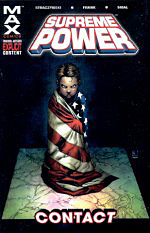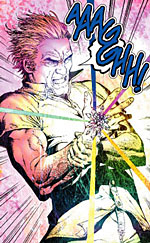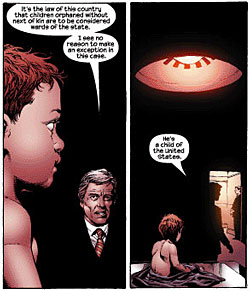>> Holding Out For A Hero
>> Making Comics Is Easy: A Cautionary Tale
More...

 Writer: J Michael Straczynski
Writer: J Michael Straczynski
Artist: Gary Frank
Colourist: Chris Sotomayor
Letterer: Rus Wooten, Chris Eliopoulos
Inker: Jon Sibal
Collecting SUPREME POWER #1-6
Price: $14.99
Publisher: Marvel Max
ISBN 0-7851-1224-3
I should open this review with something of a confession. I've never read the original SQUADRON SUPREME. I've heard about it over the years, and seen the occasional guest appearance of the characters in regular Marvel universe books. As I understand it, the Squadron Supreme were JLA analogues who decided that the best way to protect their world was to take it over. When I picked up the first SUPREME POWER trade, I was unsure what to expect. Surely the story had already been told? Was this merely going to be a retread of the original, updated for a new audience, or would we get something different.
Supreme Power is a Max book, which gives it far more freedom than a normal Marvel Universe book would have, allowing it to deal with situations that would normally be glossed over, or pushed to one side because they couldn't be dealt with effectively in an all ages book. For all that though, this could easily be an Ultimate book. You see, this is the origin of Squadron Supreme, re-imagined.
The basic plot begins with a ship crashing into a field in small rural town in America's heartland. A young couple investigates, and find a child inside, which they take home, thinking it a blessing since they can't seem to have a child of their own. It's a familiar tale, but the similarities soon end, and what follows is perhaps a more realistic take on the Superman origin.
 When the original Superman concept was dreamt up in the 1940s there would have been no radar tracking systems to follow the ship on its descent to Earth, and no rapid reaction squad to rush into action once it hit. Since Supreme Power begins in the 1970s, it introduces a whole new ballgame.
When the original Superman concept was dreamt up in the 1940s there would have been no radar tracking systems to follow the ship on its descent to Earth, and no rapid reaction squad to rush into action once it hit. Since Supreme Power begins in the 1970s, it introduces a whole new ballgame.
Therefore the child is claimed by the US military, which ultimately decides to raise him as an American citizen, with what it see as American values. The child, now named Mark Milton, is essentially brainwashed into thinking whatever the US military wants him to think, with the aim of his eventually becoming America's ultimate secret weapon.
This being the first collection of what is an ongoing series, the story focuses more on the development of Mark Milton and the Hyperion project than any other member of the book's cast, following his childhood and education through several different administrations, through to his eventual outing to the general public and his first meeting with some of the other heroes.
Three other 'heroes' are introduced through the course of the storyline, and two more are hinted at, driving the story forward by degrees, and allowing it to develop at a relatively relaxed pace. Indeed, the biggest criticism leveled at the series thus far is that relatively little seems to have happened. There is some truth in this, but it's a reasonable consequence of the structure of the story, which looks at the broader picture of how the events in the book are affecting both the general populace and the lives of the people around the edges of the story.
 This first volume should act as a primer for the rest of the series, introducing the basic concepts and launching a number of subplots. To use the terms of Straczynski's more familiar medium of television, this would perhaps be the first half of the first season, where all of the groundwork is laid out. As with television series, each chapter of the story can be read on its own, while driving forward the greater whole.
This first volume should act as a primer for the rest of the series, introducing the basic concepts and launching a number of subplots. To use the terms of Straczynski's more familiar medium of television, this would perhaps be the first half of the first season, where all of the groundwork is laid out. As with television series, each chapter of the story can be read on its own, while driving forward the greater whole.
As is typical of Straczynski, there are elements here that hint at a much grander arc beyond that of any of the individual characters, and its one that clearly won't follow the blueprint laid down by Mark Gruenwald. This isn't a straightforward update of the SQUADRON SUPREME story, but an excuse to take advantage of the same basic idea that Gruenwald pursued when he created these JLA analogues - the opportunity to create a superhero universe where events can have the sort of extreme consequences and ramifications not usually permitted in a shared universe.
Renewing his partnership with Straczynski after their work on MIDNIGHT NATION, artist Gary Frank complements the story perfectly, bringing an element of visual realism to the book. While the characters still look heroic, they don't look too showy or splashy. They look how heroes in the movies look; iconic without being garish. Frank understands the practicalities of Straczynski's 'real' superhero universe.
SUPREME POWER has been well received, with some even describing it as the greatest JLA story ever told, and others claiming it as the next step in the evolution of superhero comics. Reading this volume on it's own isn't enough to equip anyone to make that judgement, but what is clear from this volume is that it marks the beginning of something that could be very special indeed. If Straczynski and Frank can maintain this quality and get their big ideas to pay off, this will certainly be the first great superhero saga of the 21st century. However history eventual judges it, this is where it all begins. And this is most definitely where you should start reading.

This article is Ideological Freeware. The author grants permission for its reproduction and redistribution by private individuals on condition that the author and source of the article are clearly shown, no charge is made, and the whole article is reproduced intact, including this notice.


